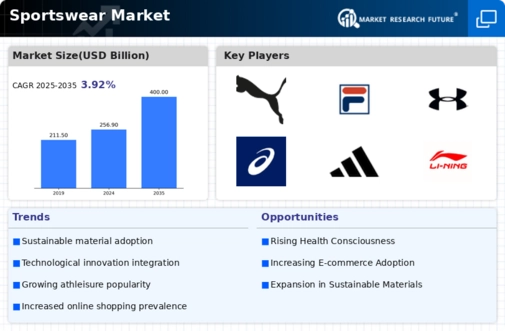Market Growth Charts
Rising Health Consciousness
The increasing awareness of health and fitness among consumers drives the Global Sportswear Market Industry. As individuals prioritize physical well-being, the demand for sportswear that supports active lifestyles grows. This trend is particularly evident in urban areas where fitness culture is thriving. For instance, the market is projected to reach 256.9 USD Billion in 2024, reflecting a robust consumer shift towards healthier living. Brands are responding by innovating with technologically advanced fabrics and designs that enhance performance and comfort. This heightened focus on health is likely to sustain growth in the sportswear sector, as more consumers seek apparel that aligns with their fitness goals.
Influence of Athleisure Trend
The athleisure trend significantly impacts the Global Sportswear Market Industry by blurring the lines between athletic and casual wear. Consumers increasingly prefer versatile clothing that can transition from workouts to everyday activities. This shift is evident in the rising popularity of yoga pants, joggers, and stylish sports tops that cater to both fitness enthusiasts and fashion-conscious individuals. As a result, the market is projected to grow at a CAGR of 4.11% from 2025 to 2035, reflecting the sustained demand for comfortable yet fashionable sportswear. Retailers are capitalizing on this trend by expanding their athleisure collections, further driving market growth.
Growth of E-commerce Platforms
The expansion of e-commerce platforms plays a pivotal role in shaping the Global Sportswear Market Industry. Online retailing offers consumers convenience and access to a wider range of products, which is particularly appealing to tech-savvy younger generations. In 2024, the market is expected to benefit from this shift, as more consumers opt for online shopping for sportswear. E-commerce not only facilitates easy comparison of prices and products but also allows brands to reach global audiences without the constraints of physical retail locations. This trend is likely to continue, with e-commerce projected to account for an increasing share of the market, thereby driving overall growth.
Technological Advancements in Fabric
Innovations in fabric technology significantly influence the Global Sportswear Market Industry. The development of moisture-wicking, breathable, and lightweight materials enhances athletic performance and comfort. For example, brands are increasingly utilizing synthetic fibers and smart textiles that adapt to body temperature and movement. These advancements not only improve the functionality of sportswear but also appeal to consumers seeking high-performance gear. As the market evolves, the integration of technology into sportswear is expected to attract a broader audience, potentially contributing to the projected growth to 400 USD Billion by 2035. This trend indicates a shift towards more specialized and performance-oriented products.
Increasing Participation in Sports and Fitness Activities
The growing participation in sports and fitness activities is a key driver of the Global Sportswear Market Industry. As more individuals engage in recreational and competitive sports, the demand for specialized sportswear rises. This trend is particularly pronounced among younger demographics, who are increasingly involved in fitness programs and organized sports. The market's expansion is supported by initiatives promoting physical activity and wellness at community levels. With the projected market size reaching 400 USD Billion by 2035, this increasing engagement in sports is likely to sustain demand for high-quality sportswear designed to enhance performance and comfort.























